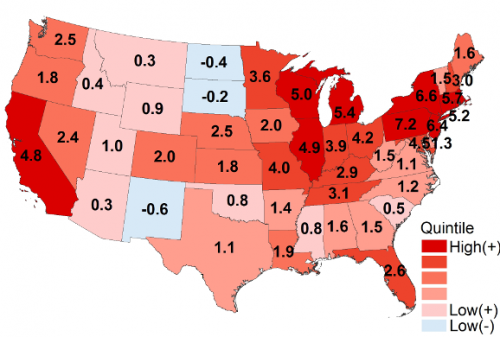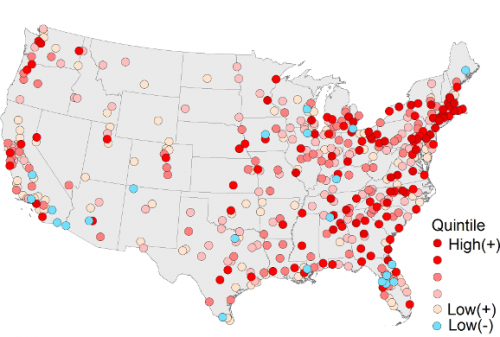Groundbreaking nationwide study finds that people of color live in neighborhoods with more air pollution than whites

A first-of-its-kind study by researchers at the University of Minnesota found that on average nationally, people of color are exposed to 38 percent higher levels of nitrogen dioxide (NO2) outdoor air pollution compared to white people.
Nitrogen dioxide comes from sources like vehicle exhaust and power plants. Breathing NO2 is linked to asthma symptoms and heart disease. The Environmental Protection Agency has listed it as one of the seven key air pollutants it monitors. The researchers studied NO2 levels in urban areas across the country and compared specific areas within the cities based on populations defined in the U.S. Census as "nonwhite" or "white."
The health impacts from the difference in levels between whites and nonwhites found in the study are substantial. For example, researchers estimate that if nonwhites breathed the lower NO2 levels experienced by whites, it would prevent 7,000 deaths from heart disease alone among nonwhites each year.
The study entitled "National patterns in environmental injustice and inequality: Outdoor NO2 air pollution in the United States" was published in the April 15 issue of PLOS ONE, a leading peer-reviewed scientific journal.
"We were quite shocked to find such a large disparity between whites and nonwhites related to air pollution," said Julian Marshall, a civil engineering associate professor in the University of Minnesota's College of Science and Engineering and co-author of the study. "Our study provides a great baseline to track over time on important issues of environmental injustice and inequality in our country."
The research builds on a recently published University of Minnesota study that used satellite data and land use information to look at nitrogen dioxide pollution throughout the continental United States (excluding Alaska and Hawaii), including all 448 urban areas defined by the U.S. Census. In the present study, the researchers overlaid the pollution information with U.S. Census data about where people live. The results provide groundbreaking evidence of environmental disparities nationwide.

The researchers found that in most areas, lower-income nonwhites are more exposed than higher-income whites, and on average, race matters more than income in explaining differences in NO2 exposure. They also found that New York, Pennsylvania and Illinois had the largest exposure gaps between whites and nonwhites, irrespective of income. The urban areas with the largest exposure gaps between whites and nonwhites were New York/Newark, Philadelphia and Bridgeport/Stamford, Conn.
The 15 states with the largest exposure gaps between whites and nonwhites were (from highest disparity to lower):
- New York
- Pennsylvania
- Illinois
- Michigan
- New Jersey
- Rhode Island
- Massachusetts
- California
- Wisconsin
- Connecticut
- Missouri
- Ohio
- Kentucky
- Indiana
- Minnesota
Note: The list above reflects disparities by race alone, irrespective of income. The map below reflects disparities by race-income.
Difference in population-weighted mean NO2 concentrations (ppb) between lower-income nonwhites and higher-income whites for U.S. states.
The 15 urban areas* with the largest exposure gaps between whites and nonwhites were (from highest disparity to lower):
- New York—Newark; NY—NJ—CT
- Philadelphia; PA—NJ—DE—MD
- Bridgeport—Stamford; CT—NY
- Boston; MA—NH—RI
- Providence; RI—MA
- Detroit; MI
- Los Angeles—Long Beach—Santa Ana; CA
- New Haven; CT
- Worcester; MA—CT
- Springfield; MA—CT
- Rochester; NY
- Chicago; IL—IN
- Birmingham; AL
- Hartford; CT
- Milwaukee; WI
Note: The list above reflects disparities by race alone, irrespective of income. The map below reflects disparities by race-income group.
Visit the University of Minnesota Marshall Research Group website for the full listing of states and urban areas studied.
"Our findings are of broad interest to researchers, policy makers and city planners," said Lara Clark, co-author of the study and civil engineering Ph.D. student in the University of Minnesota's College of Science and Engineering. "The next step in the research would be to look at why this disparity occurs and what we can do to solve it."
More information: * As defined by the U.S. Census

















